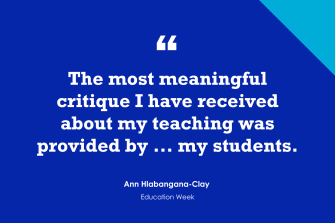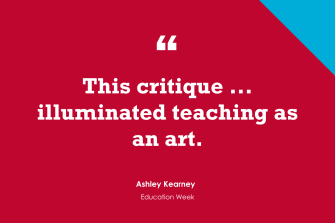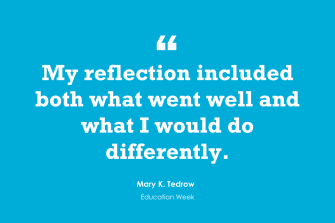(This is the first post in a three-part series.)
The new question of the week is:
What was the most meaningful critique you have received about your teaching—how was it communicated and how has it affected your practice?
It’s never easy to hear, or give, critique, but we obviously all can learn from the experience.
Today, Ann Hlabangana-Clay, Ashley Kearney, Keisha Rembert, and Mary K. Tedrow share their experiences. Ann and Ashley were also guests on my 10-minute BAM! Radio Show. You can also find a list of, and links to, previous shows here.
I’m with Ann and Keisha, who discuss the value of student feedback. You can learn about my experiences at My Best Posts On Students Evaluating Classes (And Teachers).
Listen to Students
Ann Hlabangana-Clay has been an instructional leader, coach, and presenter serving students and adult learners in Delaware and Pennsylvania for 28 years. She is host of the Coaching You Through All Things Education Podcast:
As an educator for 28 years, I have had many supervisors, principals, teacher leaders, and mentors provide constructive feedback. I have welcomed it all by keeping a growth mindset.
The most meaningful critique I have received about my teaching was provided by the least-tapped feedback group—my students. I modeled an SEL strategy for how to react when frustrated and shared that I have challenges with this, too. I simply asked my class to gently remind me when I mishandled my frustration and to provide me with feedback for ways to improve. They were more than willing subjects, and it didn’t take long for the opportunity to surface.  This request for feedback helped every learner realize I was human and to feel as if they belonged.
This request for feedback helped every learner realize I was human and to feel as if they belonged.
The same is true as an administrator. The least-tapped feedback group is our staff. I’ll never forget how powerful this model was after a code red lockdown last year. A group of educators, office staff, and a custodian were discussing some of their concerns the following day after the lockdown. Though our admin team had discussed our successes and concerns with the safety team the previous afternoon, this group of four had insights and perspectives we’d not heard or anticipated. I inserted myself into their discussion with a listening ear.
After they had exhausted their concerns and posed some possible solutions, I stated that I want my staff to see me as transparent and to feel free to share feedback regarding school safety or any topic anytime. I wanted to convey to them that their voices mattered. I assigned myself an accountability partner to check in about my progress with the action steps that developed from the feedback. I could not grow and better serve my students and staff without the knowledge that I learned that day and I valued having that authentic feedback that established a culture of improvement and grace.

‘I Needed to Approach Lessons Differently’
Ashley Kearney is an award-winning educator focusing on systemic changes that can support the whole child:
One of my assistant principals complimented a task she observed during my lesson. She then asked me about my approach to the lesson. After listening, she asked me how I think the lesson would have gone if the task was presented first. I hadn’t originally thought about it that way, but thinking aloud revealed what I assumed about scaffolding and the unintentional inequities that existed in my classroom.
After talking through what my goal was with the lesson for all students, I realized that I needed to approach lessons differently. Not only did I have more success with fully engaging all students, but my lessons became clearer for students, especially regarding a unit’s north star. Lessons became more of a collective journey that everyone was invested in, sought to collaborate on, and celebrate wins of individuals and the collective.
This critique was the tweak I needed to complement my practice as a whole. It provided the space necessary for me to observe my own practice in order to better work on articulation of my intentional teacher actions and why. The shift illuminated teaching as an art.

‘There Was Buzz and Life in The Classroom’
Keisha Rembert is an award-winning educator who is passionate about anti-racism and equity in schools. Currently, Keisha is a doctoral student and an assistant professor of teacher preparation at National Louis University:
My most meaningful critique came from a student. I cannot even remember the context and I am not sure they even meant it as a critique. The student said, “Y’all don’t listen to us anyway.” It was said without any malice, and I am sure the student did not understand the brevity of the comment. Honestly, I did not, at first, myself. I could have blown it off as a typical middle schooler complaining, but it nagged me. Is that why my students were merely going though the motions? There was truth, and I had to grapple with the sheer honesty of statement. Everything in my students world was dictated, and I had not been aware enough to get their input, to release the controls of a class that they really controlled through apathy to even listen to them.
I am so grateful for that student’s critique. It really transformed my teaching. Soon after, I enacted “student focus groups.” They became cogenerative learning spaces. Students join me to plan units of study. They made texts and content selections, helped craft lessons and assessments and then co-taught the unit with me. It renergized my students and I. There was buzz and life in the classroom. There was shared ownership of learning, and it was real. We were listening to one another, and since then, I have not stopped listening and learning from and with students.

‘Self-Reflective Practices’
Mary K. Tedrow taught in the high school English classroom beginning in 1978, ending her K-12 career as the Porterfield Endowed English Chair at John Handley High School in 2016. She currently teaches and directs the Shenandoah Valley Writing Project at Shenandoah University in Winchester Va. Tedrow is also a lecturer at Johns Hopkins University and the author of Write, Think, Learn: Tapping the Power of Daily Student Writing Across Content Areas:
Two experiences resulted in meaningful critiques, both of which transformed my teaching practice. Unfortunately, neither was a part of the official school observations—but they could be.
The first came at the end of the Invitational Summer Institute of the National Writing Project. During our summer, we each demonstrated an effective lesson for our peers. All of the fellows from every discipline and grade level were exceptional teachers. Our community was built through the shared risk of making our classroom practice public.
The critique was a collaborative discussion among the teachers and institute staff who had observed the lesson during the week. Because I had seen and esteemed everyone’s work, the opinions were valued. The discussion protocol asked presenters to first describe “What went well?” That self-assessment was followed by the group’s observations on what they considered a successful teaching practice. This discussion was followed by the question “What would you do differently?” Again, the presenter spoke first, and then the others offered suggestions around revisions.
Though the critique had meaning for that particular lesson, its framework had lasting value. These two powerful questions became a guideline for my own reflective practice in the years that followed. The second question is particularly powerful in its invitation for improvement, even if the teaching is already strong.
The second critique came during a bid for national-board certification. In this process, the teacher videos him or herself and then writes a reflection based on watching the video. The questions used in the institute were a guide to objectively viewing the tapes. My reflection included both what went well and what I would do differently. After writing about the changes needed, I enacted them.
These two experiences were indeed transformative. They provided a framework for continual improvement and built valuable, trusted professional relationships. The trust encouraged professional discussions around practice for the life of my career.
Both models could be a part of every teacher’s job if the time and framework were built into the day. The encouragement to talk and share with other classroom teachers about pedagogy has the power for ongoing reform everywhere. I had to go outside of my system and building for the professional support that encouraged both lifelong learning and continually improvement.
The self-reflective practices also bleed into the classroom. My experiences taught me to bring students in on evaluating their own work. Students work hard when they have individualized goals for improvement. Thinking and writing about improvement heightens the likelihood that change will occur.

Thanks to Ann, Ashley, Keisha, and Mary for contributing their thoughts!
Consider contributing a question to be answered in a future post. You can send one to me at lferlazzo@educationweek.org. When you send it in, let me know if I can use your real name if it’s selected or if you’d prefer remaining anonymous and have a pseudonym in mind.
You can also contact me on Twitter at @Larryferlazzo.
Education Week has published a collection of posts from this blog, along with new material, in an e-book form. It’s titled Classroom Management Q&As: Expert Strategies for Teaching.
Just a reminder; you can subscribe and receive updates from this blog via email (The RSS feed for this blog, and for all EdWeek articles, has been changed by the new redesign—new ones are not yet available). And if you missed any of the highlights from the first 11 years of this blog, you can see a categorized list below.
I am also creating a Twitter list including all contributors to this column.
window.fbAsyncInit = function() {
FB.init({
appId : ‘200633758294132’,
xfbml : true,
version : ‘v2.9’
});
};
(function(d, s, id){
var js, fjs = d.getElementsByTagName(s)[0];
if (d.getElementById(id)) {return;}
js = d.createElement(s); js.id = id;
js.src = “https://connect.facebook.net/en_US/sdk.js”;
fjs.parentNode.insertBefore(js, fjs);
}(document, ‘script’, ‘facebook-jssdk’));
!function(f,b,e,v,n,t,s)
{if(f.fbq)return;n=f.fbq=function(){n.callMethod?
n.callMethod.apply(n,arguments):n.queue.push(arguments)};
if(!f._fbq)f._fbq=n;n.push=n;n.loaded=!0;n.version=’2.0′;
n.queue=[];t=b.createElement(e);t.async=!0;
t.src=v;s=b.getElementsByTagName(e)[0];
s.parentNode.insertBefore(t,s)}(window, document,’script’,
‘https://connect.facebook.net/en_US/fbevents.js’);
fbq(‘init’, ‘344596112942513’);
fbq(‘track’, ‘PageView’);






Leave a Reply